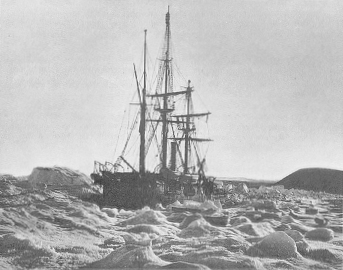British Arctic Expedition facts for kids
The British Arctic Expedition was a big trip made by the British Navy in 1875-1876. It was led by Sir George Strong Nares. The main goal was to try and reach the North Pole by sailing through a narrow passage called Smith Sound.
Even though the expedition didn't reach the North Pole, the team explored a lot of the coasts of Greenland and Ellesmere Island. They also gathered a huge amount of scientific information about the Arctic region.
Exploring the Arctic
Two ships, HMS Alert and HMS Discovery, set sail from Portsmouth on May 29, 1875. Captain Henry Frederick Stephenson was in charge of the Discovery.
On this journey, Nares became the first explorer to sail his ships all the way north through the channel between Greenland and Ellesmere Island. This channel is now called Nares Strait in his honor. Before this, many people thought this route would lead to an "Open Polar Sea," a part of the Arctic that was always free of ice. But Nares found only a vast area covered in thick ice.
A team using sleds, led by Commander Albert Hastings Markham, set a new record for the Farthest North. They reached 83° 20′ 26″ N. At the same time, senior lieutenant Lewis Beaumont led another dogsled team from Discovery Harbour. In April 1876, they traveled east to explore the northwestern shores of Greenland. They reached Sherard Osborn Fjord before turning back on May 22.
The expedition faced many challenges. The men suffered badly from a disease called scurvy, which is caused by a lack of vitamin C. They also had problems with their clothing and equipment, which were not suitable for the extreme cold. Realizing his men might not survive another winter stuck in the ice, Nares quickly sailed south with both ships in the summer of 1876.
Despite the difficulties, naval officers and mapmakers, including Thomas Mitchell, successfully took many photographs. They documented the native peoples and landscapes of what would later become Canada's Northwest Territories and Nunavut.
Several places in the Arctic are named after people from this expedition. Petty Officer Adam Ayles has both the Ayles Ice Shelf and Mount Ayles named after him. Other places include the Markham Ice Shelf, Nares Strait, Repulse Harbour, and Alert. Alert is the most northerly place on Earth where people live permanently. Pelham Aldrich was a lieutenant on the expedition. He led the Western Sledge Party to Ellesmere Island, where Cape Aldrich was named in his honor.
What Happened Next
After the expedition returned to Britain, both Nares and the British Navy faced criticism. People questioned why the expedition came back after less than a year in the Arctic. There was also concern about the outbreak of scurvy among the crew. An official report from the Navy said that some decisions made during the sledging journeys were unwise and contributed to the scurvy problem.
See also
- Cartographic expeditions to Greenland
- List of Arctic expeditions


